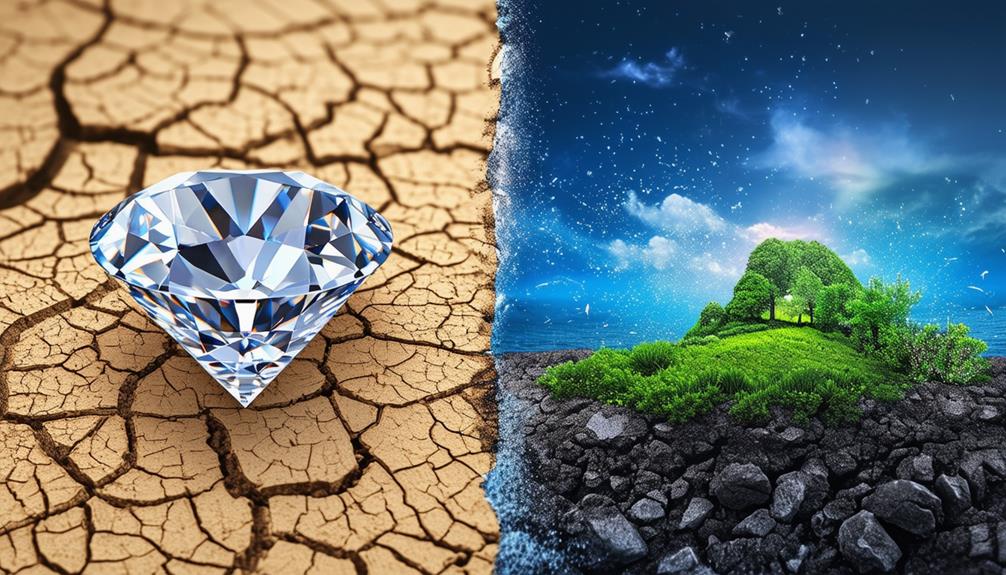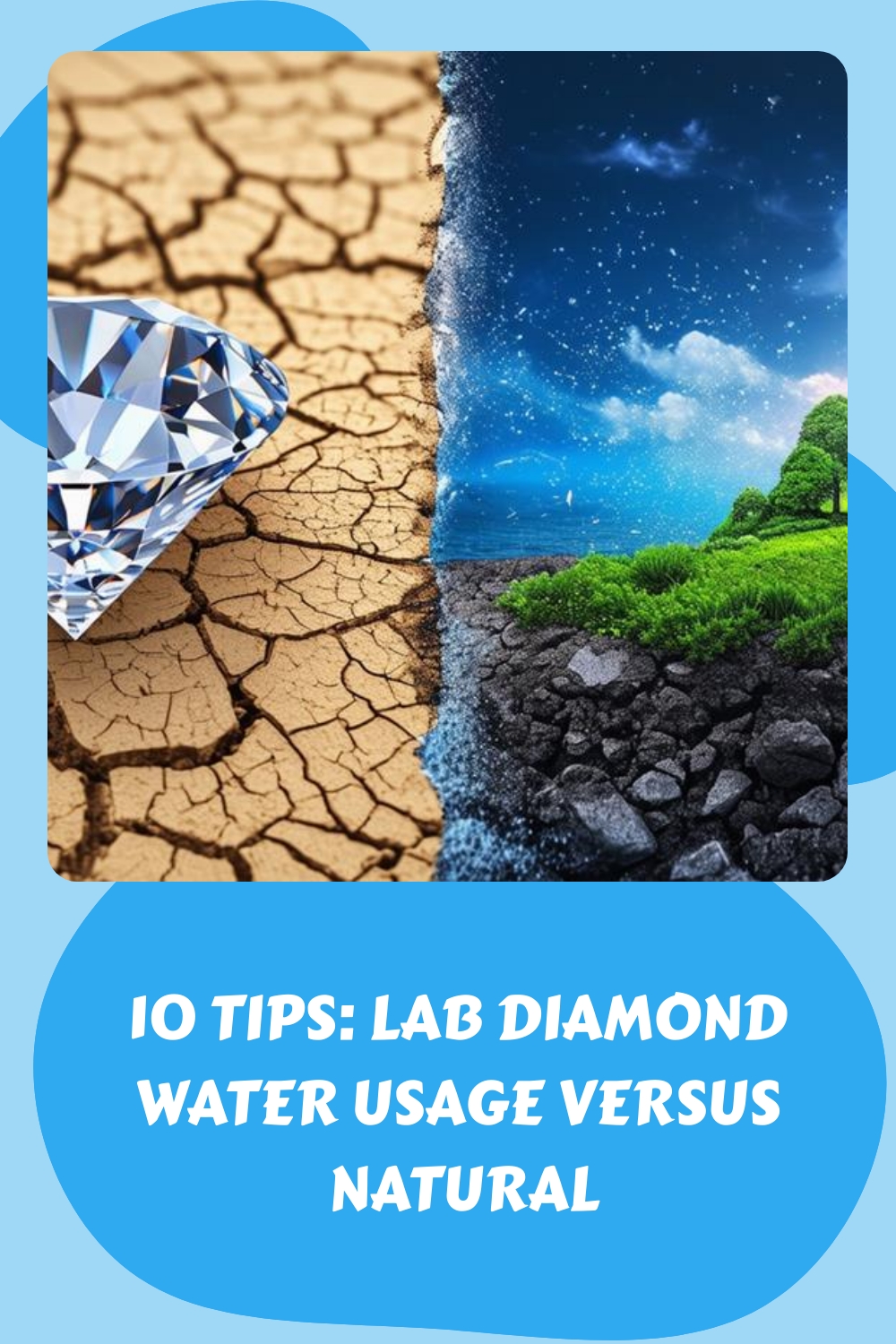Article Contents
- 1 Key Points
- 2 Understanding Water Usage
- 3 Lab Diamond Production Process
- 4 Natural Diamond Mining Techniques
- 5 Water Efficiency in Laboratories
- 6 Environmental Benefits of Lab Diamonds
- 7 Water Impact of Open Cast Mining
- 8 Comparative Analysis: Laboratory vs Natural
- 9 Sustainable Jewellery Options
- 10 Future of Diamond Industries
- 11 Consumer Guide to Eco-Friendly Diamonds
- 12 Frequently Asked Questions
- 13 Conclusion
Lab-grown diamonds significantly reduce environmental impact by using far less water compared to mined diamonds. Traditional diamond mining, involving open-pit and alluvial methods, not only requires extensive water but also damages ecosystems.
In contrast, lab-created diamonds are produced in controlled environments with a focus on minimising water usage and adhering to environmental standards. This approach not only conserves water resources but also supports sustainable practices globally. Choosing lab-grown diamonds promotes environmental conservation and advances in jewellery technology, demonstrating a commitment to ecological responsibility.
The benefits of lab-grown diamonds in terms of water conservation and environmental impact are becoming increasingly recognised.
Key Points
- Lab-grown diamonds require considerably less water than mined diamonds, enhancing water conservation efforts.
- The use of advanced water recycling technologies in diamond laboratories significantly reduces the environmental impact, offering a more sustainable alternative to traditional diamond mining.
- By choosing lab-grown diamonds, consumers contribute to the preservation of natural water resources by diminishing the reliance on extensive mining practices.
- The production process for lab-grown diamonds is controlled and sustainable, ensuring environmental preservation.
- Supporting lab-grown diamonds promotes sustainable practices within the jewellery industry and lessens the ecological footprint associated with traditional diamond procurement.
Understanding Water Usage
Understanding water usage is key in assessing the environmental impacts of lab-grown versus mined diamonds. A detailed comparison shows that historically, mined diamonds required significantly more water per carat than lab-grown diamonds. However, recent data shows a decrease in water consumption for mined diamonds, from 0.676 cubic meters to 0.125 cubic meters per carat over seven years. Despite this reduction, lab-grown diamonds continue to have a lower water usage rate.
The environmental benefits of choosing lab-grown diamonds are especially notable in terms of water conservation. This is important as it supports global efforts towards sustainable and eco-friendly practices. Opting for lab-grown diamonds not only helps preserve natural water resources but also promotes technological innovations in jewellery production that are environmentally responsible.
Choosing lab-grown diamonds is a conscious decision for those who prioritise sustainability. It allows individuals to make choices that positively impact the environment, demonstrating a commitment to both style and ecological responsibility.
Lab Diamond Production Process
In the lab diamond production process, the design of the growth chamber and the selection of the carbon source are crucial. These factors directly influence the quality and properties of the lab-created diamonds.
Carefully calibrated growth chambers and high-purity carbon sources ensure the production of aesthetically pleasing and environmentally sustainable diamonds.
Growth Chamber Setup
Lab-grown diamond growth chambers operate under high-pressure, high-temperature conditions that simulate the natural environment in which diamonds form. These chambers maintain precise control over temperature and gas composition, which are critical for producing diamonds that match the quality of natural ones in terms of brilliance and clarity.
Stability in pressure is essential for optimal carbon deposition from gases such as methane and hydrogen. Unlike natural diamond mining, which often involves significant water use, these chambers are designed to minimise water consumption, highlighting their role in promoting environmental sustainability.
This efficient use of resources reflects both the technological advancement and the ecological responsibility of the synthetic diamond industry.
Carbon Source Selection
Choosing the right carbon source, such as methane, is crucial in the Chemical Vapor Deposition (CVD) process used to create high-quality synthetic diamonds. The selection of carbon source directly affects the purity and growth rate of the diamonds, which in turn influences essential attributes like clarity and overall quality. Optimal carbon source selection is key to achieving the desired properties, such as colour and clarity, which are critical for the appeal of diamonds.
| Factor | Influence on Quality | Implications |
|---|---|---|
| Carbon Source | High | Purity, Clarity |
| Growth Rate | Direct | Quality Control |
| Carbon Purity | Vital | Optimal Outcomes |
A thorough understanding of these factors ensures that each synthetic diamond replicates the brilliance and structure of its natural counterparts.
Natural Diamond Mining Techniques
Exploring natural diamond mining techniques highlights several methods, each with distinct environmental and economic impacts.
Open-cast mining, involving the removal of vast amounts of earth, significantly alters landscapes and disrupts ecosystems.
In contrast, alluvial mining and underground mining also pose unique challenges and effects, emphasising the need for a comprehensive understanding of their long-term consequences on environmental and human health.
Open-Cast Extraction Methods
Open-cast mining is a common method used for extracting natural diamonds, involving the creation of large pits in the earth to reach the gemstones. This technique is highly effective for accessing valuable resources but causes significant environmental harm. The process leads to major disruptions in ecosystems and landscapes, often causing permanent damage. Moreover, it poses serious health risks to workers due to exposure to dust, noise, and the dangerous nature of rock blasting and excavation activities.
| Aspect | Description |
|---|---|
| Environmental Impact | Major disruptions to landscapes and ecosystems |
| Health Risks | High risk from dust, noise, and dangerous methods |
| Extraction Technique | Use of rock blasting and extensive excavation |
| Resource Intensity | High, due to the extensive nature of operations |
Alluvial Mining Processes
Alluvial mining, although less environmentally intrusive than open-cast methods, still poses significant impacts. This technique involves extracting diamonds from riverbeds and shorelines, utilising the natural movement of water to separate valuable gems from sediments. Here are some refined points about alluvial mining:
- Uses natural water currents to segregate diamonds from other materials.
- Requires minimal mechanical interference, helping to preserve the environment.
- Implements traditional methods such as panning and sluicing, which are less demanding on resources.
- Minimises the need for deep excavations, reducing disruption to ecosystems.
Despite its advantages, alluvial mining is a compromise that still affects ecosystems and communities, necessitating careful management to mitigate its environmental footprint.
Underground Mine Operations
Underground diamond mining involves constructing deep tunnel networks to access diamond deposits that are not viable through surface mining. This method requires drilling vertical shafts and digging horizontal tunnels close to kimberlite pipes, which is generally more complex and expensive than open-cast mining.
The process faces significant challenges, including the risk of flooding from water ingress, necessitating stringent safety protocols to ensure miner safety. Regular maintenance of mining equipment is crucial to avoid disruptions and maintain operational efficiency.
Precision in blasting techniques is essential to safely extract diamonds from their hard rock surroundings, combining traditional mining methods with precise modern engineering practices.
Water Efficiency in Laboratories
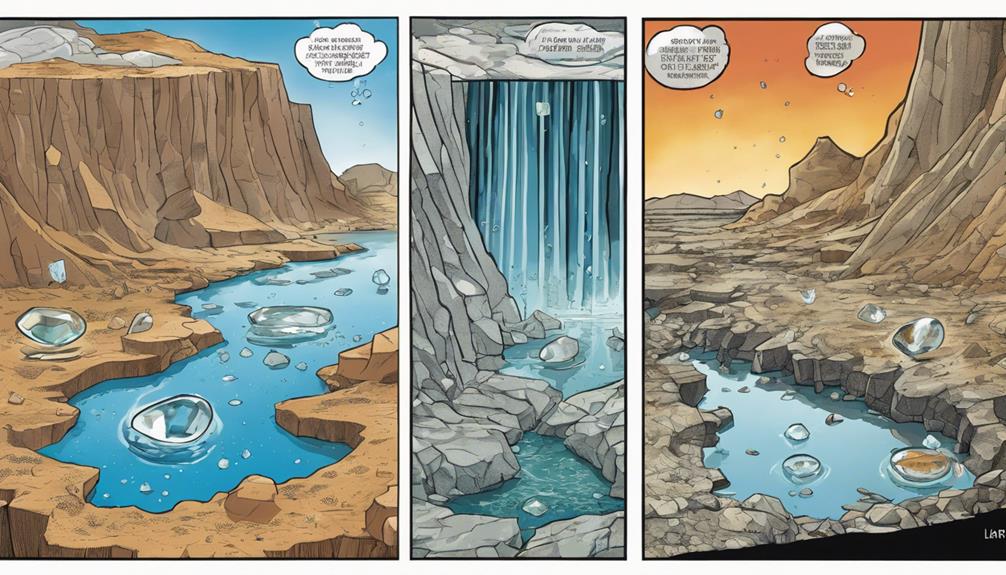
Enhancing water efficiency in laboratories that produce lab-grown diamonds is crucial for reducing environmental impact and conserving resources. These facilities prioritise the meticulous management of water usage, adhering to sustainable practices and water conservation principles. Such strategies not only align with environmental objectives but also promote operational sustainability by reducing excessive resource consumption.
Key strategies for ensuring water efficiency in these laboratories include:
- Recycling Systems: The implementation of advanced water recycling technologies allows for the treatment and reuse of water within the lab, significantly decreasing the reliance on external water sources.
- Precision Water Use: State-of-the-art equipment is employed to accurately measure and control water flow, ensuring minimal waste during the diamond production process.
- Process Optimisation: Techniques for continuous improvement are utilised to streamline and minimise water usage without compromising diamond quality.
- Regulatory Compliance: Laboratories commit to strict environmental regulations, often surpassing the minimum standards to ensure their practices are sustainably sound.
These measures collectively foster a responsible and sustainable approach to synthesising high-quality, ethically produced lab-grown diamonds, thereby supporting environmental sustainability and offering consumers eco-friendly alternatives.
Environmental Benefits of Lab Diamonds
Lab-grown diamonds present a significant environmental advantage by using significantly less water than traditional mined diamonds. This advancement in the jewellery industry promotes water conservation, reducing the environmental impact associated with diamond acquisition. By minimising water use, lab diamonds reduce the pressure on natural water resources, demonstrating a commitment to environmental preservation.
The production of lab-grown diamonds requires considerably less water, making them a more sustainable choice for environmentally conscious consumers. This method allows individuals to enjoy the beauty of diamonds while reducing the environmental harm typically associated with their extraction.
Here's a brief comparative analysis:
| Aspect | Lab-Grown Diamonds | Mined Diamonds |
|---|---|---|
| Water Usage Per Carat | Minimal | High |
| Eco-Friendliness | High | Low |
| Sustainability | Sustainable | Less sustainable |
| Consumer Freedom of Choice | High | Limited |
Choosing lab-grown diamonds supports water conservation and eco-friendly initiatives, contributing to the health of our planet. This choice enables consumers to align their purchases with their environmental values, promoting responsible and sustainable consumer behaviour.
Water Impact of Open Cast Mining
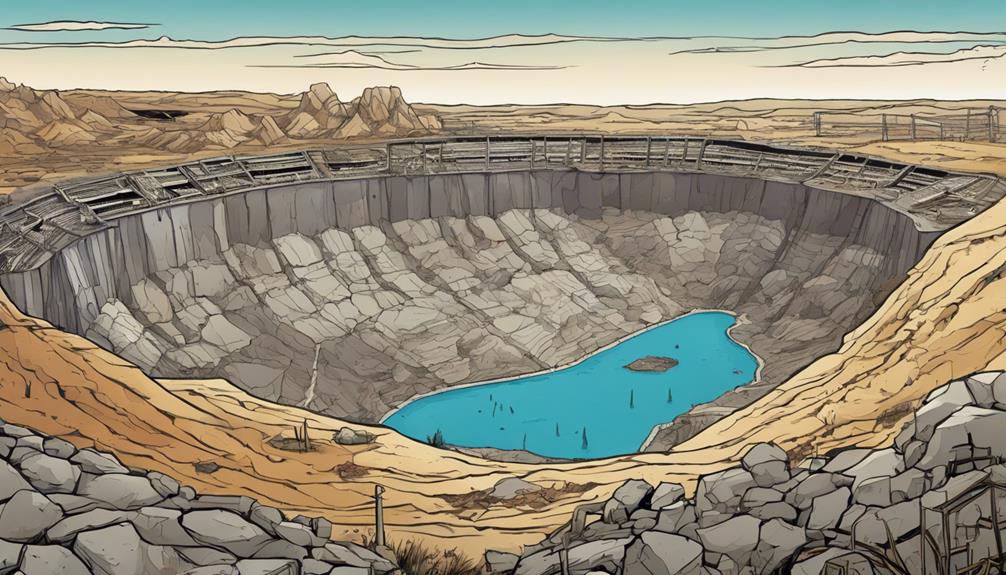
Open-cast diamond mining, a common extraction method, has a significant impact on water resources by using around 500,000 to 1 million gallons of water per carat. This high water usage not only reduces local water supplies but also creates challenges for sustainable water management and ecosystem conservation, especially in dry areas where water is essential for human and environmental well-being.
Key aspects of water usage in open-cast mining include:
- Dust Suppression: Water is necessary for controlling dust during the excavation process.
- Ore Processing: Large quantities of water are required to extract diamonds from mined materials.
- Equipment Maintenance: Water is used to clean and cool heavy machinery, which helps prevent overheating and reduces damage.
- Ecosystem Impact: Changes in water flow can damage habitats and reduce biodiversity.
To address these issues, it is essential to adopt water conservation practices and implement technologies that support water recycling and reduce overall water consumption. These actions are crucial for safeguarding ecosystems and ensuring the long-term sustainability of communities that depend on these water resources.
Comparative Analysis: Laboratory vs Natural
In our assessment of water consumption, it is crucial to analyse the environmental impacts of both lab-grown diamonds and naturally mined diamonds.
Lab-grown diamonds are notable for their reduced water usage, which is significantly lower compared to traditional mining methods. Although natural diamond mining has improved in water efficiency, it still consumes more water than the production of synthetic diamonds.
This comparison not only highlights the sustainability practices within gemstone production but also emphasises the importance of ecological conservation in the jewellery industry.
Water Consumption Comparison
Lab-grown diamonds are a more water-efficient option than natural diamonds, using around 18 gallons of water per carat compared to the 126 gallons per carat used in natural diamond mining. This significant difference highlights the environmental benefits of lab-grown diamonds, particularly in terms of water conservation.
Key considerations include:
- Reduced Water Usage: Lab-grown diamonds greatly reduce water consumption, promoting sustainable production methods.
- Environmental Stewardship: Opting for lab-grown diamonds helps to conserve water resources, which are vital for maintaining ecological balance.
- Sustainability Comparison: The minimal water footprint of lab-grown diamonds makes them a more environmentally conscious choice.
- Informed Decisions: Understanding these facts can help consumers make choices that align with their environmental principles.
Environmental Impact Assessment
Expanding our environmental impact assessment to include water usage, we find that lab-grown diamonds typically have a lower water footprint per carat compared to natural diamonds. This finding highlights the greater eco-efficiency of lab-grown diamonds in terms of water use.
Although there has been some reduction in water usage for natural diamonds, lab-grown diamonds consistently show superior performance in sustainability metrics. This information is crucial for consumers prioritising environmentally responsible choices.
Therefore, lab-grown diamonds not only appeal aesthetically and ethically but also excel in sustainable practices, representing a responsible choice in luxury goods.
Sustainable Jewellery Options

Opting for sustainable jewellery options like lab-grown diamonds can significantly reduce water usage and the overall environmental impact within the diamond industry. For those prioritising sustainability and ethical choices, lab-grown diamonds offer an effective alternative with substantial positive implications for both the environment and industry practices.
Consider these key benefits of choosing lab-grown diamonds:
- Reduced Environmental Footprint: Lab-grown diamonds consume far less water compared to mined diamonds, leading to a lower environmental impact.
- Support for Water Conservation: The production of lab-grown diamonds incorporates water-saving techniques, appealing to environmentally conscious consumers.
- Promotion of Responsible Practices: Opting for lab-grown diamonds encourages the adoption of water-efficient practices throughout the diamond industry.
- Sustainability: Lab-grown diamonds provide a more sustainable choice, helping to ensure the planet's long-term well-being.
Choosing lab-grown diamonds allows consumers to appreciate the elegance of fine jewellery while committing to environmental sustainability and responsible industry innovation. This decision not only demonstrates a dedication to ecological preservation but also encourages further progress in creating eco-friendlier jewellery options.
Future of Diamond Industries
The diamond industry is increasingly adopting sustainable practices and ethical sourcing, driven by consumer preferences for responsibly sourced gems. This shift towards sustainability is significant, fundamentally altering the industry's values and methods of operation.
Technological innovations are crucial to this change, reducing environmental damage and improving the efficiency of diamond extraction and processing. Blockchain technology enhances traceability, ensuring that the procurement of each diamond meets high ethical standards. This level of transparency is crucial for meeting the expectations of consumers who prioritise integrity and accountability in their purchases.
Moreover, collaborations between industry participants and regulatory authorities are shaping a new era in diamond production that respects both environmental and human rights. These partnerships are instrumental in creating a sustainable future for the diamond industry, where ethical practices are integral to its success.
This commitment to ethical sourcing and sustainability is set to be the foundation of the industry's future, aiming to establish a legacy of respect, responsibility, and ecological consciousness.
Consumer Guide to Eco-Friendly Diamonds
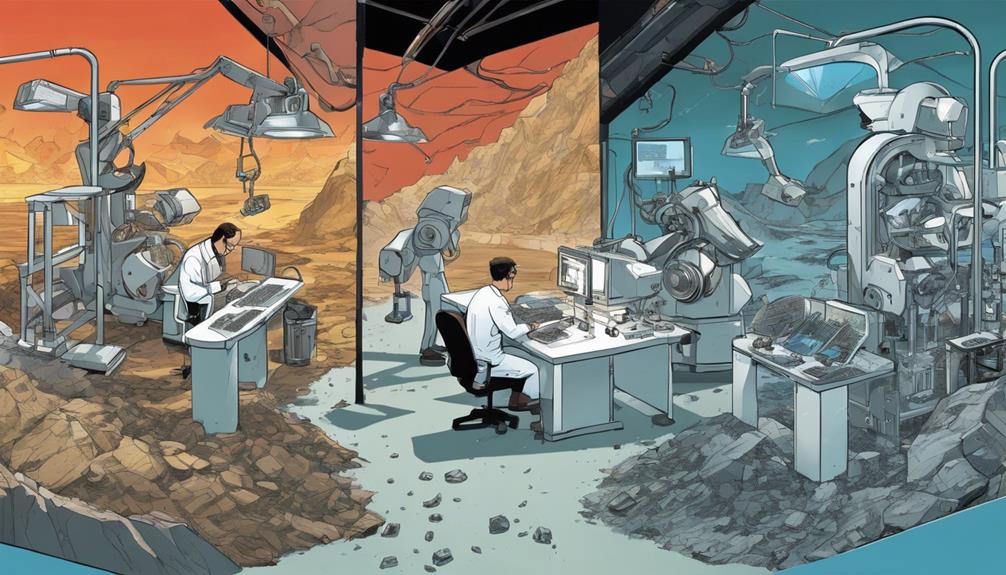
When choosing eco-friendly diamonds, consider the following:
- Sustainable Sourcing: Lab-grown diamonds provide an ethical option by reducing the environmental harm associated with traditional diamond mining.
- Reduced Water Usage: Selecting lab-grown diamonds significantly lowers water consumption per carat, aligning with eco-conscious values.
- Encouraging Innovation: Purchasing lab-grown diamonds drives the demand for technology that decreases environmental impacts.
- Long-Term Impact: Supporting lab-grown diamonds encourages the jewellery industry to adopt sustainable practices, contributing to a healthier planet.
For those who prioritise environmental responsibility and want to make a positive impact, choosing lab-grown diamonds is a meaningful way to support sustainable advancements in the jewellery industry. This choice not only saves water but also leads the way to a more sustainable and transparent diamond market.
Frequently Asked Questions
Can lab-grown diamonds be submerged in water?
Yes, lab-grown diamonds can safely be submerged in water. They are chemically resistant and can be cleaned using various methods without altering their appearance or losing their brilliance.
Do Lab-Grown Diamonds Sparkle More Than Natural Diamonds?
Lab-grown diamonds and natural diamonds usually show comparable levels of sparkle, as this characteristic is mostly determined by the diamond's cut and craftsmanship rather than its source. Both kinds of diamonds can display outstanding brilliance if they are well-crafted.
Are Lab-Grown Diamonds Actually Eco-Friendly?
Lab-grown diamonds are more environmentally friendly than mined diamonds, as they use less energy and produce less waste. This makes them a sustainable option in the jewellery industry.
What is the carbon footprint of lab-grown diamonds compared to natural diamonds?
Lab-grown diamonds typically have a significantly smaller carbon footprint than natural diamonds. On average, producing one carat of lab-grown diamond results in approximately 4 pounds of CO2 emissions. In contrast, extracting and processing a carat of natural diamond generates about 140 pounds of CO2. This stark difference is primarily due to the more energy-efficient production methods used in creating lab-grown diamonds and the elimination of extensive mining activities.
Conclusion
In the realm of gemstones, the comparison between lab-created diamonds and natural diamonds highlights important sustainability aspects. Laboratories producing diamonds use significantly less water, positioning lab-grown diamonds as a more sustainable choice for eco-conscious consumers.
As the industry shifts towards these eco-friendly options, it suggests that even luxury items like diamonds can evolve to meet ethical standards. Opting for lab-grown diamonds may indeed set a new standard for sustainable luxury.

